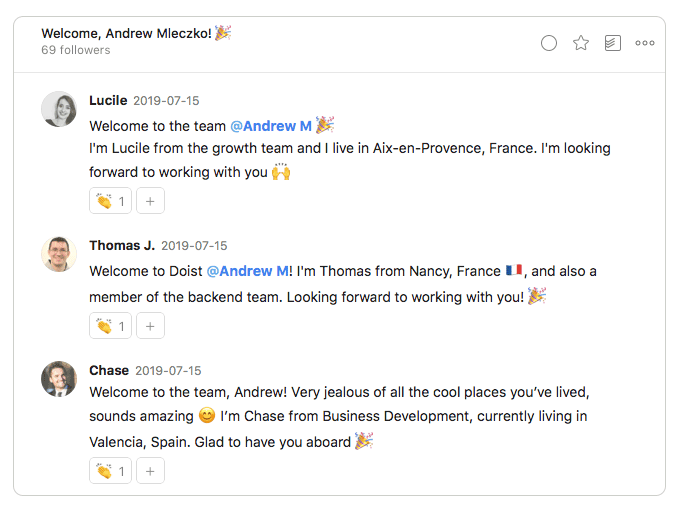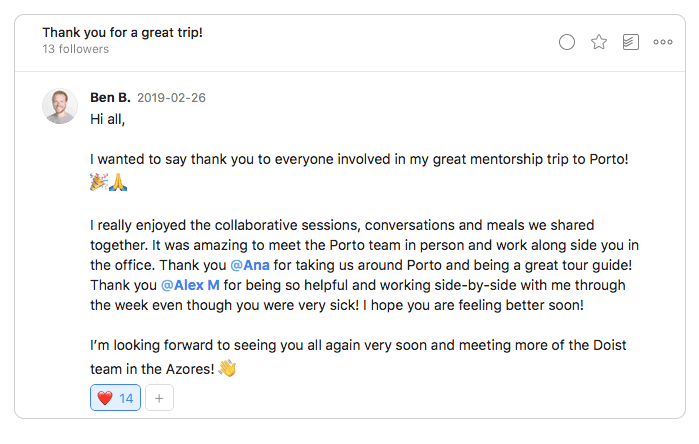Hiring is only half of the equation when building your remote team. The other half is increasing the likelihood that your new team members will stay and setting them up for success through remote onboarding.
On someone’s first day at the office, you can greet them in the morning with a welcome package in hand. You’ll show them to their desk, introduce them to everyone, set up a meeting, and explain the training process. At noon you’ll swing by their desk, tell them to stop working and come grab lunch with the team. This constant and intentional contact over the upcoming weeks will help them get familiarized with the company, the work they’ll be doing, and who they’ll be doing it with.
Onboarding on a remote team is different. It’s often done virtually: an introductory handshake becomes an introductory message and a welcome lunch becomes asynchronous greetings that might span several days across multiple time zones. Mastering remote onboarding is crucial and will ensure new team team members to thrive in their role.
Handling Logistics
Work closely with finance and your people operations team to ensure your new employee receives all the appropriate paperwork to get paid on time. Check in with them to verify the process has gone smoothly.
This is particularly important on a remote team where you may be paying people through different systems and currencies. See our Remote Company Setup Guide for more on how to structure your remote team, including everything from incorporation to compensation.
Remember: new team member often won’t raise issues regarding pay in an attempt to avoid conflict when they first join a company. It’s your job to ensure that everything’s in order on the administrative side so they can simply focus on doing their job.
Introducing New Team Members
Your team might already know that a hiring process was taking place, but may be unaware of the successful candidate. Give them a head-up beforehand about the new hire and how their role will fit into the larger team.
Before your new report begins, ask them for a short bio about themselves which you can use to introduce them. Ask them for information on the following:
A few details about themselves (e.g. location, hobbies)
Where they worked before
What skills they’ll bring to the team
What they’re looking forward to about starting their new role
A few photos of themselves (optional)
These introductions are key and help make new team member’s feel welcomed and embraced by the team.
Making a Good First Day Impression
Without a plan in place, the first day on a remote team can feel lonely and disorienting.
Rather than stepping into an office, your new team member will login through your company’s team communication tool. This is their first introduction to the wider team, so ensure your team's conversations are organized. This way, new team members can go back and get up to date about what’s transpired at a company before they began.
<product-tip>Introduce new members of your team by starting a dedicated Welcome thread in Twist. Use the Giphy integration to add some excitement!</product-tip>
At Doist, we start a welcome thread in Twist for each new member that joins our team with the title “Introducing [First Name] to the Team”.

The first post of this thread is often written by their manager and includes information from the bio they provided, what they’ll do at Doist, and encourages everyone to give them a warm welcome. People respond with their name, where they’re working from, and what team they’re on.
Additionally, ensure that their manager or Human Resources provides them with some structure on their first day.

Director of People, Buffer
On someone’s first day they get set up on all our tools, sync up with their lead and key points of contact, enjoy a robust welcome GIF party, and read through some key docs about our vision, mission, and values.
Send them a swag package. If possible, arrange for a swag package to be sent to their home before they start. This can include items like a t-shirt, water bottle, laptop stickers, and even a personalized short note welcoming them to the team.
Arrange a first day meeting. A direct manager and/or someone from Human Resources should schedule a video call to welcome them to the team face-to-face. Let new hires know they’re free to ask any questions. Express excitement about them joining the team. Walk them through what their onboarding will look like and what they can expect over the next few days and weeks.
Encourage their team members to message them. It can be awkward to introduce yourself one-on-one over messages as the _new person_. In side conversations, remind their team members to make the first move and personally welcome them to the team.
Providing a New Hire Checklist
Giving new hires a way to feel like they’re learning and making progress on the job is crucial. In advance, create a list of to-dos for them and think of small scale responsibilities you can provide them with to warm-up.
At Doist, we use Todoist to onboard new team members, and include a variety of tasks related to learning more about our products and team culture.
Onboarding task lists should be department specific and modified slightly for each person. Approach creating an onboarding checklist with “foundation items” that everyone who joins should complete and then “department items” that are specific to a certain area.
Foundation items could include the following:
Read articles or listen to podcasts that describe your company’s ethos
Read your company’s general documentation
Request access to all general software and cloud accounts used internally (i.e. Google Drive, Dropbox, etc.)
Department items for a Software Engineer could include the following:
Set up meeting to get introduced to the code base
Gain access to the company’s GitHub account
Schedule pair programming call with a senior developer
A new hire checklist is important and helps build momentum and confidence. It may take a few days or weeks to finish.
Don’t equate a new hire checklist with onboarding. Successful onboarding takes months. It’s more than a checklist.
A new hire checklist is simply a starting point. Onboarding includes everything from those first day introduction to the first big project they work on independently.
Pairing Them With a Mentor
A good practice for onboarding a new remote team member is to pair them with a mentor. This shouldn’t be direct manager, but someone senior on their team.
This mentor relationship should last anywhere from the first three to six months of a new team member’s tenure. A good mentor acts as a point of contact for any questions or concerns and should regularly meet with their mentee. Once a week is a good cadence for meetings.

CTO, Doist
Mentoring is critical. Working remotely can be isolating, and asking questions can be intimidating. To counter this, it’s important to make mentorship and feedback loops as explicit as possible. Conversely, you might not need an explicit mentor in a typical office setting. You’re sitting sitting side by side with your peers all day, every day. Mentorship is implied, even if undefined, throughout the numerous face-to-face interaction day in and day out. This difference makes it even more important that this challenge is acknowledged and proactively worked on.
At Doist, we arrange Mentor Trips where a new teammate flies to meet their mentor in a different city and works with them in person for a week. This can expedite and ease the learning process and strengthen the bond between mentors and mentees.

Mentor trips should be optional and timed at the convenience of your new hire. Remember, parents with small children, primary caregivers, and others may not be able to take a week to travel to a new city our country.A mentor is a trusted guide to help new team members navigate an unfamiliar environment and feel less isolated on a remote team.
Extending Responsibilities
Once your latest team member has completed a few new hire tasks, it’s time to extend true responsibility to them. Give them a small project that is low-pressure but allows them to use their skills and problem solving skills. Keep these points in mind when handing over responsibility to a new hire:
Provide the context of the project. Before giving new hires projects, give them all the details about why the project is important and how it fits into the wider picture. Let them know if similar projects have been completed before and show them examples that may clarify the assignment.
Set expectations. Don’t be ambiguous about the level of quality you expect and how quickly you might want the project completed. Give specifics about what the final product might look like and also provide a specific due date.
Give them points of contact. It’s rare that a project can be completed from start to finish without input from other team members. However, new team members often don’t know the right person to contact for the right information. Provide them with information on the best people on the team to reach out to and even make the introductions for them.At a certain point during the onboarding process, managers need to relinquish control and provide their new reports with tangible things to do. Make this as early as possible so they truly feel trusted and part of the team. These initial responsibilities serve to build confidence and clear room for your new hire to take on more ambitious work.
Checking In Regularly
Stay in close communication with new employees and regularly initiate conversations with them. This serves multiple purposes:
Establishing they can reach out to you whenever necessary
Reducing the feeling of loneliness and isolation
Building a rapport
Ask them about how onboarding is going, whether they’re encountering any issues in their role, and whether they feel supported. Don’t always check-in about work. If they’ve mentioned hobbies or interest to you, bring those up or send them interesting articles or videos about something they’ve mentioned.

People Operations, Doist
As a People Operations or Human Resources team member, your role begins and ends with people, so you have to be very sensitive and aware of your team feels and what challenges they’re experiencing so you can reinforce practices that are helping your team thrive and develop solutions to address existing issues.
Asking for Feedback
During and after their onboarding process, request feedback so you can ultimately course correct or improve the process for the future. Let them know you would like their radical candor in assessing their first few days, weeks, or months at a team. Here are a few questions to ask to understand their experience:
How did your first few weeks here compared to your experience at other companies?
What could we have done better to make your transition here easier?
What parts of the onboarding process helped you understand our team better?
So far, is this job what you expected? If not, what could we have done to communicate the role better?
Is there anything I can do to better support you?
Don’t ask new team members all these questions at once. Instead, ask one or two questions intermittently throughout their first few weeks, or even months, on the job.
If they answer honestly and that feedback is critical, it’s key not to act defensively or take feedback personally. Instead, let them know you’ll work on fixing the issue and do exactly that.
If their concerns are relevant to other departments like Human Resources or Finance, make sure to share this feedback with them.
If their feedback pertains to management style, leaders should seek out resources that may be relevant or speak with peers.
If their feedback relates to other members of the team, be careful and sensitive in sharing feedback in a way that doesn’t create rifts or affect morale.
Feedback is a gift. Use it to improve onboarding in the future so that your next hire has a better experience.
Conclusion
Building a global remote team takes careful planning and consideration. It also requires creating a company based on trust and cultural appreciation. Sourcing talented people from across the world is one part. Providing the environment they need to thrive is another.
Combining thoughtful hiring and intentional onboarding will enable you to collaborate across countries as you scale your remote team.

